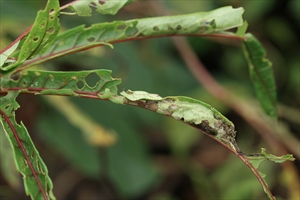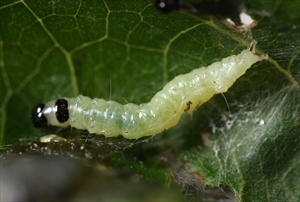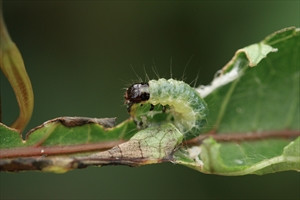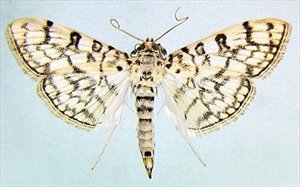Cotton leaf roller, bele leaf roller
Pacific Pests, Pathogens and Weeds - Online edition
Pacific Pests, Pathogens & Weeds
Bele (Abelmoschus) leaf roller (087)
Haritalodes derogata; previously, it was known as Sylepta derogata.
Asia, Africa, Oceania. It is recorded from Australia, Fiji, Papua New Guinea, Samoa, and Solomon Islands.
Bele (aibika, island cabbage or sliperi kabis, local names for Abelmoschus manihot). The moth is also a pest of ornamental Hibiscus, cotton, okra, and some weeds.
The caterpillars roll the leaves, remaining inside the tunnel they create, eating the leaves at the edges and between the main veins.
Eggs are laid singly or in groups on the underside of the leaves. At first, the larvae stay together and feed on the undersides, only later staying alone inside folded leaves (Photo 1). From the second moult they have two dark spots just behind the head on the first segment of the thorax (Photos 2&3). After a short pupal stage, the adults emerge. Their wings are cream with a continuous line along the outer and back border of the wings, and dark-brown 'scattered' lines elsewhere (Photo 4). The wingspan is 30-40 mm. The life cycle of the bele leaf roller is about 30 days from egg to adult.
The damage is extensive with broad-leafed varieties appearing to suffer more than those with deeply divided leaves (Photo 5). Curling, drooping and defoliation of leaves is common (Photo 6).
Look for rolled leaves. Look for webbing around the caterpillar, which has two spots on the top of the segment behind the head. The spots are a characteristic feature of the bele (cotton) leaf roller.
NATURAL ENEMIES
Apart from spiders and praying mantids, there are few records of predators and parasites attacking the bele leaf roller.
CULTURAL CONTROL
Before planting:
- Do not plant next to crops that are already infested with the bele leaf roller.
During growth:
- If only a few plants are infested with the bele leaf roller, do the following:
o Pinch rolled leaves between finger and thumb, squashing the caterpillar inside.
o Prune the rolled leaves; remove the cuttings from the garden and burn them.
After harvest:
- Collect the plants and debris after harvesting the leaves for the last time, and burn them.
CHEMICAL CONTROL
If pesticides are necessary, use botanical (plant-derived pesticides) sprays first, as these will cause less harm to natural enemies, and cost less, than synthetic commercial products.
- Use neem, derris, pyrethrum or chilli. If these are used, add soap to help the chemical reach the caterpillars within the rolled leaves.
- Alternatively, use commercial biopesticides, e.g., spinosad (the product is called Success) or Bt -Bacillus thuringiensis var. kurstaki (the product is called Dipel).
- If using Dipel, note the following:
- Ensure that Bt covers the plants; caterpillars will only die if they eat Bt.
- Eggs are not susceptible to Bt.
- Use Bt as soon as damage is seen.
- Small larvae are more susceptible to Bt than fully grown ones.
- Synthetic pyrethroids are likely to be effective, but will also kill natural enemies.
____________________
When using a pesticide, always wear protective clothing and follow the instructions on the product label, such as dosage, timing of application, and pre-harvest interval. Recommendations will vary with the crop and system of cultivation. Expert advice on the most appropriate pesticides to use should always be sought from local agricultural authorities.
AUTHORS Helen Tsatsia & Grahame Jackson
Information from Crosby TK, Cocks G (2013) Cotton leaf roller (Haritalodes derogata): PaDIL - http://www.padil.gov.au; and CABI (2020) Haritalodes derogata (cotton leaf roller). Crop Protection Compendium. (https://www.cabi.org/cpc/datasheet/52198). Photos 1-3 Suzanne Neave, CABI, UK. Photo 4 Georg Goergen, IITA/Insect Museum, Cotonou, Benin.
Produced with support from the Australian Centre for International Agricultural Research under project PC/2010/090: Strengthening integrated crop management research in the Pacific Islands in support of sustainable intensification of high-value crop production, implemented by the University of Queensland and the Secretariat of the Pacific Community.









